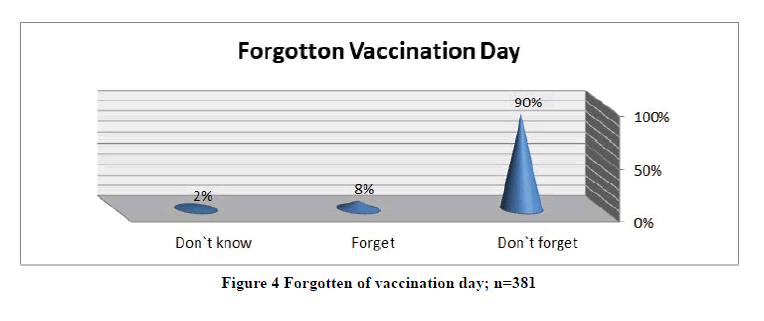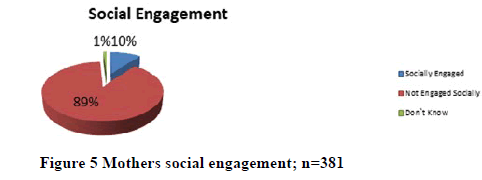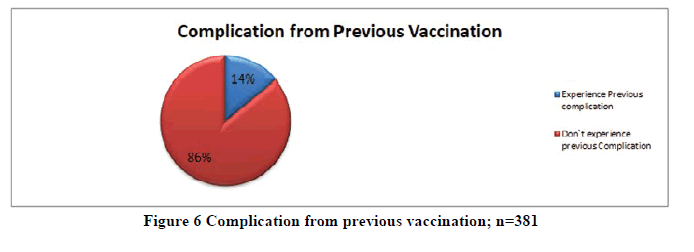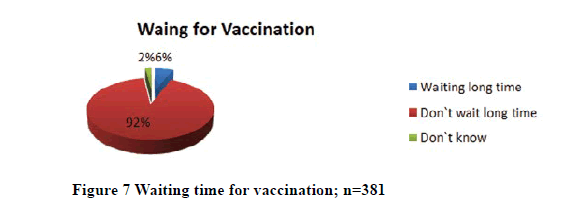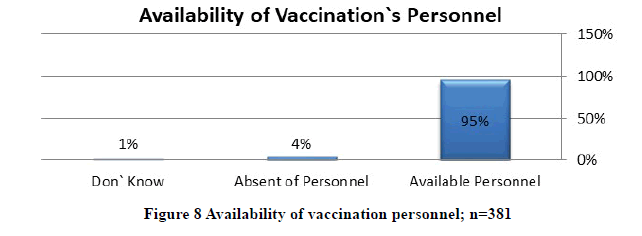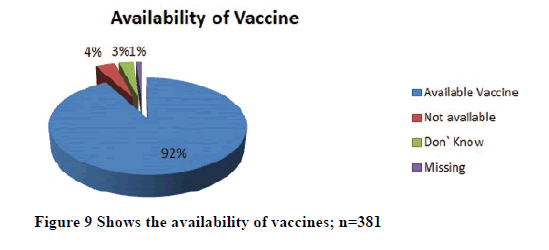Research - International Journal of Medical Research & Health Sciences ( 2021) Volume 10, Issue 3
Contributing Factors of Incomplete Childhood Primary Vaccination, Sudan
Samia Adam Fadiel Abu1, Mohamed Osman Elamin2* and Hatim Rahmtullah12Faculty of Public Health, Umm-Al-Qura University, Kingdom of Saudi Arabia
Mohamed Osman Elamin, Faculty of Public Health, Umm-Al-Qura University, Kingdom of Saudi Arabia, Email: mohsm71@yahoo.com
Received: 23-Feb-2021 Accepted Date: Mar 23, 2021 ; Published: 30-Mar-2021
Abstract
Vaccination is the administration of a vaccine to stimulate a protective immune response that prevents disease in the vaccinated person if contact with the corresponding infectious agent occurs subsequently. Thus vaccination, if successful, results in immunization. Immunization prevents millions of deaths every year and reducing the risk of disability caused by infectious diseases. The poorest children typically have access to a smaller range of vaccines and are at greater risk from the hazards of unsafe immunization practices. This descriptive cross-sectional communitybased study has been conducted in Eldaein in 2020 to investigate the contributing factors of incomplete childhood primary vaccination. 381 participants were selected by multi-stage sampling techniques and data was collected by questionnaire and analysis by using the SPSS program, and χ2 tests. The study revealed that 13.9%, 14.4%, 36.1% and 13.4% of the participants experience complications from previous vaccination, long-distance, difficult transportations to the health facilities, respectively. The study also revealed that educational level and household monthly income have a statistically significant association with the attitudes towards the effectiveness of vaccine at p>0.05, while age and household size have a statistically insignificant association with the attitudes towards the effectiveness of vaccine at p<0.05. From the result, it is clear that the level of education affects the attitude of the participants towards the effectiveness of immunization. The study recommended that; the East Darfur Ministry of Health should conduct health education programs towards vaccination.
Keywords
Incomplete, Childhood, Primary vaccination, Eldaein
Introduction
Background
Vaccination is the administration of a vaccine to stimulate a protective immune response that prevents disease in the vaccinated person if contact with the corresponding infectious agent occurs subsequently. Immunization prevents millions of deaths every year and reducing the risk of disability caused by infectious diseases. The poorest children typically have access to a smaller range of vaccines and are at greater risk from the hazards of unsafe immunization practices. Immunization is one of the most successful global health interventions and cost-effective ways to save lives and prevent diseases and is estimated to prevent more than two million deaths a year globally. The World Health Organization (WHO) launched the Expanded Programme on Immunization (EPI) in 1974 to immunize children throughout the world. The program uses proven strategies, like outreach services, to ensure the delivery of vaccines even to the most hard-to-reach and vulnerable populations. The worldwide implementation of this program has resulted in more than 100 million infants being immunized each year, saving 2-3 million lives annually. In 1984, the WHO established a standardized vaccination schedule for the original EPI vaccines which include Bacillus Calmette-Guerin (BCG), Diphtheria-Tetanus-Pertussis (DPT), oral polio, and measles [1]. In Sudan, the EPI was established in 1976 in few states but eventually expanded geographically to cover the whole country. Currently, through collaboration between the Sudanese Federal Ministry of Health, the WHO, the United Nations Children’s Fund, and the Global Alliance for Vaccines and Immunization (GAVI), the program is considered as one of the leading immunization programs in Africa [2]. Barriers to immunization may have a significant impact on vaccination rates and, consequently, on the incidence and prevalence of vaccine-preventable diseases. Barriers and challenges to immunization include individual factors, vaccination process, and vaccination system. The individual factors include; misinformation, misunderstanding the importance and benefits of vaccination, concerns about the risks and adverse effects of vaccination, wrong belief about the effect and effectiveness of the vaccinations, cultural and religious beliefs, and poor communication with/by vaccination providers. The vaccination process includes; lack of a strategic and integrated response from all healthcare professionals, complex vaccination schedules, missed vaccination appointments, reduced accessibility to vaccination providers, difficulty to schedule vaccination appointments, and lack of accurate and complete immunization records. The vaccination system includes; limitations in vaccination storage or capacity cost and lack of/inconsistent vaccine reimbursement schemes, misdistribution, financial constrain [3].
Problem Statement
Every year more than 10 million children in low and middle-income countries die before they reach their fifth birthdays because they do not access effective interventions that would combat common and preventable childhood illnesses. Vaccination remains the most effective, safest, and efficient tool to decrease morbidity and mortality rates. In 2013 estimated 29% of deaths of children of 5 years of age were vaccine-preventable [4]. Knowledge, attitudes, practices, access and accept health services remain the most serious contributing factors that need to address.
Justification of Study
EPI in Sudan is still almost completely dependent upon external aid while the government contribution is limited to operational costs. There are difficulties to reach some areas due to rural-urban migration, natural disasters, the longstanding civil war in the country. There are wide variations within the country in the delivery of services, resulting in a gap in immunization coverage. It was estimated that only 33% of the population have access to fixed immunization services in 2006. Mobile teams conduct immunization activities in remote areas in an irregular manner, whenever transport is available.
General Objectives
To investigate the contributing factors of incomplete childhood primary vaccination in Eldaein.
Specific Objectives
To identify the educational contribution factors of incomplete childhood primary vaccination in Eldaein, to determine the socioeconomic contribution factors of incomplete childhood primary vaccination in Eldaein, to define the susceptibility of health services contribution factors of incomplete childhood primary vaccination in Eldaein, and to define the acceptability of health services contribution factors of incomplete childhood primary vaccination in Eldaein.
Literature
Complication and Contradictions
Following vaccination, there may be swelling and discomfort at the injection site and mild fever and malaise. Some vaccines, such as measles and rubella, may be followed by a mild form of the disease 7-10 days later. More serious reactions, including anaphylaxis, may occur but are very rare. Vaccination should be postponed if the child has an acute illness. Live vaccines should not be given to children with impaired immune responsiveness (except in children with HIV infection in whom MMR vaccine can be given) [5].
Previous Studies
A study was undertaken in the Nyala locality, South Darfur, Sudan, revealed that contributing factors to the low vaccination coverage were found to be knowledge problems of mothers (51%), access problems (15%), and attitude problems (34%). Children whose mothers attended antenatal care and those from urban areas were more likely to complete their immunization schedule [6].
A study conducted in Rumbek, South Sudan, showed that (72.1%) of mothers/guides have good knowledge of immunization, (52.9%) have a good attitude towards immunization. Marital status, level of education, occupation, and the number of children were all found to have statistically significantly associated (p<0.05) with the mothers/ guides’ knowledge on immunization. This study further revealed that marital status, religion, level of education, and occupation have a statistically significant association (p<0.05) with the attitudes of the mothers/guides towards immunization. Vaccination compliance analysis in this study revealed a downward trend along the various vaccines/ indicators based on age and vaccines received by each respondent’s child [7].
A study conducted in Ethiopia showed that the prevalence of incompletely immunized children is 70.9%. Children of mothers from the poor wealth quintile were more likely to be incompletely immunized. Children of mothers from Affar, Amhara, Oromiya, Somali, Benishangul, Gumuz, Southern Nations Nationalities and Peoples, Gambela, and Harari regions were more likely to be incompletely immunized. Mothers with inadequate exposure to media, who are not aware of community conversation programs, and who attended no antenatal care were more likely to have incompletely immunized children [8].
A study was conducted in Addis Ababa, Ethiopia regarding reasons for incomplete vaccination. The results showed that 20% didn’t complete their vaccination according to the schedule for routine immunization. The study revealed that children were less likely to incomplete vaccination if their primary caregivers knew the benefit of vaccinating the child, the age to complete vaccination, and advised about the importance of full vaccination. Mothers’ ANC attendance and place of delivery during their last child were significantly associated with vaccination incompletion among children aged 12-23 months [9].
A study conducted in Malaysia showed that the prevalence of incomplete immunization was 4.5%, while nonimmunized was 0.1%. Logistic regression analysis revealed that children at-risk of incomplete immunization or being non-immunized were girls, residing in urban areas, have mothers who do not believe that vaccine can prevent the spread of disease and mothers, who had pregnancy care at private healthcare facilities. Among reasons given for incomplete or non-uptake of immunization were due to either private healthcare facilities reasons; vaccine stock shortage or not due for immunization yet, or personal reasons; ‘no time’, ‘forgotten’, ‘refused vaccine’, and ‘doubt halal status’ [10].
A study conducted in south Ethiopia showed that mothers of infants who are unable to read and write and attended primary school, mothers who had no postnatal care follow up, good maternal knowledge towards immunization, and maternal favorable perception towards uses of health institution for maternal and child care were significant determinant factors to default to full completion of immunization [11].
A study conducted in the hard-to-reached area of Ethiopia showed that 77.4% of children aged 12-23 months were fully immunized. Having antenatal care visit, a higher level of maternal education, mothers’ good knowledge on immunization, short distance to the health facility, and being born in health institutions had increased the odds of full immunization coverage while having five and more family size reduced the odds of children’s vaccine uptake [12].
A study conducted in northeast Brazil the study showed that the new vaccines were meningococcal C and 10-valent pneumococcal, and the old vaccines were or those already on the childhood immunization schedule. Incomplete immunization was higher with new vaccines (51.1%) than with old vaccines (33.2%). Children 25 to 35 months of age and those in economic classes D/E were only significantly associated with new vaccines; low maternal schooling, unavailability of outpatient and/or hospital care for the child, and unavailability of the vaccine in health services were only associated with old vaccines [13].
Material and Methods
A cross-section descriptive community-based study was conducted to investigate the contributing factors of incomplete childhood primary vaccination in Eldaein, East Darfour. The target populations are mothers with incomplete vaccinated children aged 12 to 23 months in the target areas. There are 7954 mothers with incomplete vaccinated children aged 12 to 23 months in the target areas according to the last population census in 2010. 381 participants were selected by the following formula; n=N/1+N × e2 and the multi-stage sampling technique is used to distribute the participants. Data was collected by structured questionnaire and analyzed by SPSS program, and tested by χ2 tests to see the association between dependent and independent variables.
Results
The study revealed that: 31% of the participant’s age was between 18 and less than 30, and 45.4% between 30 and less than 40 years old. More than two-thirds (69.8%) of the participants were over secondary educated. The majority 78.7% of the household’s income was above 4500 SDGs. 45.6% of the participants reside long distance to the health facilities and the majority 36.1% have difficult transportation to the health facilities. 93% of the participants have wrong information about vaccination, 13.9% experience complications from previous vaccination. Only 14.5% and 6.2% of the participants say that health services are accessible and acceptable, respectively.
The majority 86.9% of the participants don’t know about vaccination (Figure 1).
The majority 93% have wrong information regarding vaccination (Figure 2).
The majority 87% of the participants engage in work for earning money (Figure 3).
The majority 90% of the participants don’t forget vaccination day, while only 8% forget vaccinated day (Figure 4).
The majority 89% of the participants were socially engaged (Figure 5).
14% of the participants experience a complication from previous vaccination, while the majority doesn’t (Figure 6).
6% of the participants wait long for vaccination, while the majority 92% don’t (Figure 7).
95% of the vaccination’s personnel were available (Figure 8).
92% of the participants showed that vaccines are available while 4% showed that vaccines are not available (Figure 9).
The majority 83% of the participants heard about the vaccinated day (Figure 10).
Most 62% of the participants strongly agreed and 34% agree that vaccine protects a child from certain diseases (Figure 11).
Most 62% of the participants strongly agreed and 28% agree that vaccine is safe (Figure 12).
There is a significant association between educational level and attitudes towards the effectiveness of vaccine at χ2=64.118; df=16; p-value=0.000 (Table 1).
| Educational level | Attitudes towards the effectiveness of the vaccine | Total | ||||
|---|---|---|---|---|---|---|
| Strongly agree | Agree | No opinion | Disagree | Strongly disagree | ||
| Illiterate | 23 (6.1%) | 15 (4.0%) | 13 (3.4%) | 4 (1.1%) | 2 (0.5%) | 57 (15.0%) |
| Primary | 31 (8.2%) | 17 (4.5%) | 5 (1.3%) | 2 (0.5%) | 3 (0.8%) | 58 (15.3%) |
| Secondary | 88 (23.0%) | 36 (9.5%) | 3 (0.8%) | 2 (0.5%) | 0 (0.0%) | 129 (34.0%) |
| Graduate | 68 (17.0%) | 27 (7.1%) | 1 (0.3%) | 0 (0.0%) | 0 (0.0%) | 96 (25.3%) |
| Post graduate | 26 (6.9%) | 12 (3.2%) | 1 (0.3%) | 0 (0.0%) | 0 (0.0%) | 39 (10.3%) |
| Total | 236 (62.0%) | 107 (28.2%) | 23 (6.1%) | 8 (2.1%) | 5 (1.3%) | 379 (100.0%) |
Table 1 :Association between the level of education and attitudes towards the effectiveness of vaccine; n=381.
There is a significant association between household’s monthly income and attitudes towards the effectiveness of vaccine at χ2=58.965; df=12; p-value=0.000 (Table 2).
| Household monthly income/SDGs | Attitudes towards the effectiveness of the vaccine | Total | ||||
|---|---|---|---|---|---|---|
| Strongly agree | Agree | No opinion | Disagree | Strongly disagree | ||
| 0 to 1500 | 2 (0.5%) | 0 (0.0%) | 0 (0.0%) | 0 (0.0%) | 0 (0.0%) | 2 (0.5%) |
| 1500 to 3000 | 8 (2.1%) | 7 (1.9%) | 5 (1.3%) | 0 (0.0%) | 1 (0.3%) | 21 (5.6%) |
| 3000 to 4500 | 23 (6.1%) | 16 (4.2%) | 9 (2.4%) | 5 (1.3%) | 3 (0.8%) | 56 (14.9%) |
| >4500 | 203 (53.8%) | 82 (21.8%) | 9 (2.4%) | 3 (0.8%) | 1 (0.3%) | 298 (79.0%) |
| Total | 236 (62.6%) | 105 (27.9%) | 23 (6.1%) | 8 (2.1%) | 5 (1.3%) | 377 (100.0%) |
Table 2: Association between household’s monthly income and attitudes towards the effectiveness of the vaccine.
There is a significant association between accessibility to the health services and attitudes towards the effectiveness of vaccine at χ2=71.688; df=4; p-value=0.000 (Table 3).
| Accessibility to health services | Attitudes towards the effectiveness of the vaccine | Total | ||||
|---|---|---|---|---|---|---|
| Strongly agree | Agree | No opinion | Disagree | Strongly disagree | ||
| Yes | 15 (4.0%) | 19 (5.0%) | 13 (3.4%) | 4 (1.1%) | 4 (1.1%) | 55 (14.5%) |
| No | 221 (58.3%) | 88 (23.2%) | 10 (2.6%) | 4 (1.1%) | 1 (0.3%) | 324 (85.5%) |
| Total | 236 (62.3%) | 107 (28.2%) | 23 (6.1%) | 8 (2.1%) | 5 (1.3%) | 379 (100.0%) |
Table 3: Association between accessibility to the health services and attitudes towards the effectiveness of vaccine; n=381.
There is a significant association between acceptability of health services and attitudes towards the effectiveness of vaccine at χ2=82.850; df=8; p-value=0.000 (Table 4).
| Acceptability of health services | Attitudes towards the effectiveness of the vaccine | Total | ||||
|---|---|---|---|---|---|---|
| Strongly agree | Agree | No opinion | Disagree | Strongly disagree | ||
| Yes | 6 (1.6%) | 5 (1.3%) | 6 (1.6%) | 4 (1.1%) | 3 (0.8%) | 24 (6.2%) |
| No | 229 (60.6%) | 97 (25.7%) | 15 (4.0%) | 4 (1.1%) | 2 (0.5%) | 347(91.8%) |
| I don’t know | 1 (0.3%) | 4 (1.1%) | 2 (0.5%) | 0 (0.0%) | 0 (0.0%) | 7 (1.9%) |
| Total | 236 (62.4%) | 106 (28.0%) | 23 (6.1%) | 8 (2.1%) | 5 (1.3%) | 378 (100.0%) |
Table 4: Association between acceptability of health services and attitudes towards the effectiveness of vaccine; n=381.
Discussion
Immunization has prevented millions of deaths every year and reducing the risk of disability caused by infectious diseases. This study revealed that more than two-thirds (69.8%) of the participants were over secondary educated. Educational level is one of the most important contributing factors for incomplete primary child vaccination as there is a significant association between educational level and attitudes towards the effectiveness of the vaccine (p>0.05). This finding agreed with the study conducted in South Sudan, which showed significant relationships between level of education, occupation, and attitude toward immunization [7]. The finding of this study revealed that the majority 78.7% of participants households’ income was above 4500 SDGs, 15% was between 3500 and <4500 SDGs, and 5% between 1500 and <3000 and there was a significant association between households’ monthly income and attitudes towards the effectiveness of the vaccine (p>0.05). From the result, it’s clear that income is a contributing factor for incomplete primary child vaccination. This finding agreed with the study conducted in Ethiopia in 2015, which showed that children of mothers from the poorest and poorer wealth quintile (lack of money) and children of mothers with inadequate exposure to media were more likely to be incompletely immunized (p>0.05) [8]. The study revealed that the majority 93% and 91.1% have wrong information and wrong beliefs regarding primary vaccinations, respectively. This showed that misinformation and wrong believes were contributing factors to child incomplete vaccination. This result showed that 10% and 11% of the participants were socially engaged and engaged in work for earning money, respectively. It obvious that socially engaged and engaged in work for money were not contributing factors to the incomplete child primary vaccination. This finding disagreed with the result of a study in Addis Ababa, Ethiopia, which showed a significant association between mother engagement and attitude towards completeness of immunization [9].
The study revealed that 14.4% and 36.1% of the participants live away from the health facilities and have difficult transportation, respectively, which indicated that both weren’t contributing factors to child incomplete vaccination; therefore, they don’t affect the degree of accessibility to the health services. This finding disagreed with the finding of a study conducted in Ethiopia, which showed that long-distance is deteriorated factor to immunize children [12]. The study also revealed that 6%, 4%, and 4% of the participants wait a long time for vaccination, absence of personnel, and the lack of vaccine, respectively. These three factors form acceptability to health services or attitudes towards health services but they don’t affect the incomplete primary vaccination. This disagreed with the study in North Brazil, which showed that lack of vaccine was associated with incomplete vaccination [13].
Conclusion and Recommendation
The study concludes that educational level, (69.8% over secondary educated), income (78.7% above 4500 SDGs), misinformation (93%), and wrong believes, (91.1%) were contributing factors for incomplete primary child vaccination, while mothers’ social engagement (10%) mothers’ engagement in work for money (11%), a long-distance from health facilities (14.4%), difficult transportation (36.1%), waiting a long time for vaccination (6%), absence of personnel (4%) and lack of vaccine (4%) were not contributing factors to the incomplete and e child primary vaccination.
• The East Darfur Ministry of Health should conduct health education programs through the mass media and the community health talk to raise awareness among the community members especially mothers towards vaccination
• The East Darfur Ministry of Health should encourage the immunization teams to make the vaccination accessible to mothers by removing the obstacles of difficult and expensive transportation
• The East Darfur Ministry of Health should encourage the immunization teams to make the vaccination acceptable
Declarations
Conflicts of Interest
The authors declared no potential conflicts of interest with respect to the research, authorship, and/or publication of this article.
References
- Abaker, Suliman. "Review of Expanding Program on Immunization (EPI) in Sudan 2018." Acta Scientific Microbiology, Vol. 3, No. 3, 2020, pp. 1-4.
- Ali, Almigdad Hayder Mohammed, et al. "Immunisation of children under 5 years: Mothers’ knowledge, attitude and practice in Alseir locality, Northern State, Sudan."Sudanese Journal of Paediatrics,Vol. 20, No. 2, 2020, pp. 152-62.
- Rosado, H., and I. Bates. "An overview of current pharmacy impact on immunisation: A global report." International Pharmaceutical Federation, 2016, pp. 1-122.
- Waisbord, Silvio, and Heidi Larson. "Why invest in communication for immunization."Evidence and lessons learned. New York: A joint publication of the Health Communication Partnership based at Johns Hopkins Bloomberg School of Public Health/Centre for Communication Programs (Baltimore) and the United Nations Children’s Fund Á UNICEF,2005.
- Lissauer, Tom, and Will Carroll, eds."Illustrated textbook of paediatrics." Elsevier Health Sciences, 2017.
- Ismail, Ismail Tibin Adam, et al. "Assessment of routine immunization coverage in Nyala locality, reasons behind incomplete immunization in South Darfur state, Sudan."Asian Journal of Medical Sciences,Vol. 6, No. 1, 2014, pp. 1-8.
- Daniel, Ebenezer Obi, et al. "Factors contributing to missed opportunities and incomplete vaccination of children: A focus on mothers in Rumbek Centre County of Lakes State South Sudan."World,Vol. 4, No. 3, 2019, pp. 47-54.
- Mohammed, Raji Tajudeen. "Assessment of factors associated with incomplete immunization among children aged 12-23 months in Ethiopia." University of the Western Cape, Electronic Thesis and Dissertations Repository, 2016.
- Mesfin, Michael."Incomplete vaccination and associated factors among children aged 12-23 months in Yirgalem Town, South Ethiopia." Diss. Addis Ababa University, 2015.
- Ahmad, N. A., et al. "Primary immunization among children in Malaysia: Reasons for incomplete vaccination."Journal of Vaccines and Vaccination,Vol. 8, No. 3, 2017, pp. 1-8.
- Asfaw, Abiyot Getachew, et al. "Determinants of default to fully completion of immunization among children aged 12 to 23 months in south Ethiopia: Unmatched case-control study."Pan African Medical Journal,Vol. 23, No. 1, 2016, pp 1-8.
- Girmay, Abadi, and Abel Fekadu Dadi. "Full immunization coverage and associated factors among children aged 12-23 months in a hard-to-reach areas of Ethiopia."International Journal of Pediatrics,Vol. 2019, 2019.
- Silva, Francelena de Sousa, et al. "Incomplete childhood immunization with new and old vaccines and associated factors: BRISA birth cohort, Sso Luís, Maranhso State, Northeast Brazil."Public Health Notebooks, Vol. 34, 2018, p. e00041717.




